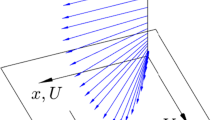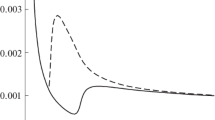Abstract
Mellor-Yamada's “superequilibrium” Level 2 and Level 1 models are analyzed using the Monin-Obukhov theory framework. Yamada's (1975) analysis is supplemented by a discussion of the realizability requirements posed on model constants and by the inclusion of the master-length scale problem. The generalized von Kármán local similarity hypothesis (Laikhtman, 1979) is examined as an alternative closure hypothesis for second-order models. A systematic method of model examination is used. First, a family of models, consisting of Level 1 and Level 2 Reynolds-stress equation sets and different length-scale hypotheses (Prandtl's, generalized von Kármán's), is built. Next, asymptotic characteristics of individual models are investigated and compared with similarity predictions. Monin-Obukhov universal functions for turbulent energy, space scale and temperature variance, derived from the models, are compared with experimental surface-layer data. Generally, models employing the stability-dependent generalized von Karman hypothesis perform better than those that use the conventional Prandtl mixing-length concept. The choice amongst the von Kármán type models is still ambiguous. However, the Level 1 model with a stability-dependent generalized von Kármán length scale seems to be the best of those considered.
Similar content being viewed by others
References
Andrén, A.: 1990, ‘Evaluation of a Turbulence Closure Scheme Suitable for Air Pollution Applications’, J. Appl. Meteorol. 29, 224–239.
Bobyleva, I. M., Zilitinkevich, S. S., and Laikhtman, D. L.: 1967, ‘Turbulent Structure in the Thermally Stratified Planetary Boundary Layer’, in Atmospheric Turbulence and Radiowave Propagation, Nauka, Moscow, pp. 179–190.
Bodin, S.: 1978, ‘Applied Numerical Modelling of the Atmospheric Boundary Layer’, SMHI Report No. RU 15, Norrkopping, Sweden.
Bodin, S.: 1979, ‘A Predictive Numerical Model of the Atmospheric Boundary Layer Based on the Turbulent Energy Equation’, SMHI Report No. RMK 13, Norrkopping, Sweden.
Delage, Y.: 1974, ‘A Numerical Study of the Nocturnal Atmospheric Boundary Layer’, Quart. J. Roy. Meteorol. Soc. 100, 5.
Detering, H. W. and Etling, D.: 1985, ‘Application of the Energy-Dissipation Turbulence Model to Meso-Scale Atmospheric Flows’, Proceedings 7th AMS Symposium on Turbulence and Diffusion, Boulder, Colorado.
Enger, L.: 1986, ‘A Higher Order Closure Model Applied to Disperson in a Convective PBL’, Atmos. Env. 20, 879–894.
Flatau, P. J.: 1985, ‘Study of Second-Order Turbulence Closure Technique and its Application to Atmospheric Flow’, Atm. Sci. Paper No. 293, Colorado State University, Colorado.
Helfand, H. M. and Labraga, J. C.: 1988, ‘Design of a Nonsingular Level 2.5 Second-Order Closure Model for the Prediction of Atmospheric Turbulence’, J. Atmos. Sci. 45, 113–132.
Laikhtman, D. L.: 1979, ‘On the Surface Layer Structure’, Izv. AN SSSR, Fiz. Atm. Ok. 15, 983–987.
Laikhtman, D. L. and Kudrova, E. V.: 1980, ‘A Model of the Planetary Boundary Layer’, Izv. AN SSSR, Fiz. Atm. Ok. 16, 690–696.
Lewellen, W. S. and Teske, M.: 1973, ‘Prediction of the Monin-Obukhov Similarity Functions from an Invariant Model of Turbulence’, J. Atmos. Sci. 30, 1340–1345.
Lobocki, L.: 1989, ‘A Description of the Atmospheric Surface Layer Structure for Environmental Engineering Applications’, PhD, Thesis, Technical University of Warsaw (in Polish).
Mellor, G. L.: 1973, ‘Analytic Prediction of the Properties of Stratified Planetary Surface Layers’, J. Atmos. Sci. 30, 1061–1069.
Mellor, G. L. and Yamada, T.: 1974, ‘A Hierarchy of Turbulence Closure Models for Planetary Boundary Layers’, J. Atmos. Sci. 13, 1791–1806.
Mellor, G. L. and Yamada, T.: 1982, ‘Development of a Turbulent Closure Model for Geophysical Fluid Problems’, Rev. Geoph. Space Phys. 20, 851–875.
Panofsky, H. A., Tennekes, H., Lenschow, D. H., and Wyngaard, J. C.: 1977, ‘The Characteristics of Turbulent Velocity Components in the Surface Layer Under Convective Conditions’, Boundary-Layer Meteorol. 11, 355–361.
Prenosil, T.: 1979, ‘Prediction of the Monin-Obukhov Similarity Functions from a Second-Order-Closure Model’, Boundary-Layer Meteorol. 17, 495–516.
Schlichting, H.: 1964, Grenzschicht-Theorie, Verlag G. Braun, Karlsruhe.
Schumann, U.: 1977, ‘Realizability of Reynolds-Stress Turbulence Models’, Phys. Fluids 20, 721–725.
Tjernström, M.: 1987, ‘A Study of Flow Over Complex Terrain Using a Three-Dimensional Model. A Preliminary Model Evaluation Focusing on Stratus and Fog’, Ann. Geoph. 5, 469–486.
Therry, G. and Lacarrère, P.: 1983, ‘Improving the Eddy Kinetic Energy Model for Planetary Boundary Layer Description’, Boundary-Layer Meteorol. 25, 63–88.
Wesely, M. L., Thurtell, G. W., and Tanner, C. B.: 1970, ‘Eddy Correlation Measurements of Sensible Heat Flux Near the Earth's Surface’, J. Appl. Meteorol. 9, 45–50.
Wichmann, M. and Schaller, E.: 1986, ‘On the Determination of the Closure Parameters in Higher-Order Closure Models’, Boundary-Layer Meteorol. 37, 323–341.
Yamada, T.: 1975, ‘The Critical Richardson Number and the Ratio of the Eddy Transport Coefficients Obtianed from a Turbulence Closure Model’, J. Atmos. Sci. 32, 926–933.
Yamada, T.: 1977, ‘A Numerical Experiment on Pollutant Dispersion in a Horizontally-Homogeneous Atmospheric Boundary Layer’, Atmos. Env. 11, 1015–1024.
Yamada, N.: 1986, ‘Examination of Schumann's Method of Judging the Realizability of Turbulence Closure Models’, Boundary-Layer Meteorol. 37, 415–419.
Zilitinkevich, S. S. and Laikhtman, D. L.: 1965, ‘Turbulent Exchange in the Atmospheric Surface Layer’, Izv. AN SSSR, Fiz. Atm. Ok. 1, 150–156.
Author information
Authors and Affiliations
Rights and permissions
About this article
Cite this article
Lobocki, L. Mellor-Yamada simplified second-order closure models: Analysis and application of the generalized von Karman local similarity hypothesis. Boundary-Layer Meteorol 59, 83–109 (1992). https://doi.org/10.1007/BF00120688
Revised:
Issue Date:
DOI: https://doi.org/10.1007/BF00120688




